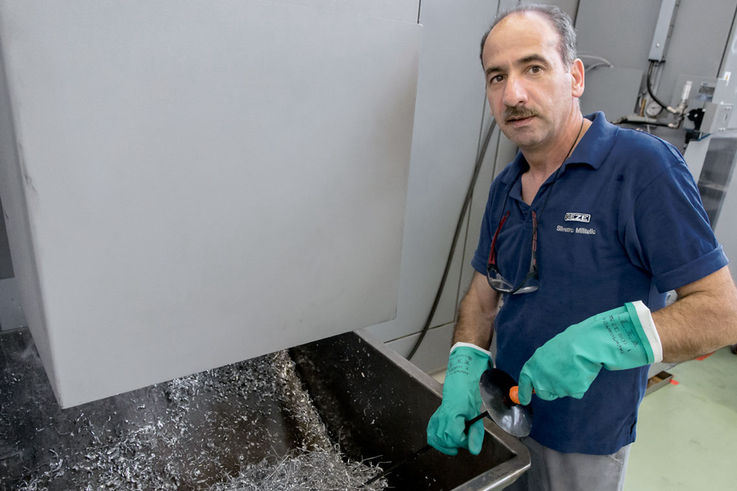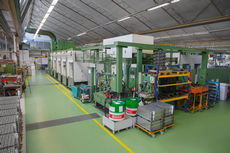Modernisation of our production facility: down memory lane with our transfer line
Our transfer line was dismantled in the first half of 2021 – after 25 years. It had slowly become obsolete and been gradually replaced by new, state-of-the-art technologies. For some colleagues, the dismantling process will undoubtedly bring back memories and perhaps invoke a little nostalgia. The transfer line had been part of their professional lives for many years and was an integral part of their working day. With this in mind, we wanted to cast the spotlight on our loyal transfer line one last time, telling its story and hearing from a few of its companions over the years.
A production system with a rich history

At the time of dismantling, some colleagues from the production department put up mementoes associated with the transfer line on a hoarding. © GEZE GmbH
Purchased from Plauen-based company Vogtland in 1995, we used the transfer line to produce standard casings for our TS 4000, TS 5000 and TS 3000 door closers. Production operations ran on a three-shift rotation, with one operator and one or two setters on each shift. Over the years, the production system was serviced and optimised time and again. For instance, a Piller unit and robots for automatic material feed were integrated.
But why did we choose to purchase the transfer line in the first place? Clearly, to increase production efficiency and optimise the processes. Previously, our overhead door closer casings were manufactured using several separate machines – but as production volumes grew, this became less cost-effective. The transfer line allowed individual production steps to be consolidated and thereby streamline the overall process.
Goodbye: An important chapter in GEZE history comes to a close

It took almost three weeks to dismantle the beloved transfer line in GEZE’s production facility. © GEZE GmbH
It had become apparent in recent years that the beloved transfer line was nearing the end of its line. It had not been in operation since 2019. The effort required to obtain spare parts and the high maintenance costs no longer made sense. In addition, the line had become long in the tooth and been replaced by new, state-of-the-art technologies. And so it finally came to pass this spring: in early 2021, we finally parted ways with the machine. Dismantling the line took eight people almost three weeks working ten-hour days. Some parts were recycled, while others were sent for scrap. Where the line once stood is now a 250 sqm space that is being used as a temporary supermarket for various products and a storage area.
The entire production team bade a wistful farewell to the transfer line as it was finally removed. After all, they had poured blood, sweat and tears into the line over the years. Having said that, the employees fully appreciate the advantages of new machines which make our production more efficient.
Close to 25 years of cherished memories
Surreal, amusing, emotional: the transfer line was an integral part of the daily work routine of many colleagues for almost 25 years. It is only natural that over the years a good stock of stories and anecdotes around this machine were accumulated:

© GEZE GmbH
Robert Keuerleber, machine setter and assistant team leader, came on board the company as junior technician after completing his training in 2002 and worked on the transfer line as a setter.
‘The transfer line was my first posting after I completed my training. The entire team was very helpful and friendly, which made the induction on this complex system easier. For a long time, the line was the centrepiece of our casing production operations – so I’m proud to have worked on it.
During my time working on the transfer line, I learnt a lot of new technical aspects that I was able to apply later in other areas.’

© GEZE GmbH
Ciro Perrotti has been part of the GEZE team since 1992: as one of the transfer line’s first machine operators, he knew the system inside and out!
‘I can clearly remember the operations to clean the transfer line – we all had to give it everything we had, every time. Overall, working on the machine was characterised by good teamwork and trusting collaboration. We all helped each other and, together with the setters, we developed and implemented a lot of improvements.’

© GEZE GmbH
Machine operator Silvestro Militello joined the company back in May 1998 and was part of the transfer line team from the very beginning. He kept the system ticking over with his own hands.
‘I can clearly remember the operations to clean the transfer line – we all had to give it everything we had, every time. Overall, working on the machine was characterised by good teamwork and trusting collaboration. We all helped each other and, together with the setters, we developed and implemented a lot of improvements.’

© GEZE GmbH
Paul Jacob joined the GEZE team back in September 1985.He was a setter on the transfer line from the beginning and, for many years, looked after the machine and kept it running as the sole setter on the night shift.
‘For me, the transfer line means 25 years of highs and lows, sweat and tears – but also happiness that I worked on the machine for so long. The line was the first fully interlinked production machine at GEZE with very complex processes, which often presented us with new tasks. However, it was a solid and good-tempered machine; it had one or two faults, but our setters and operators could forgive them. The machine should ideally work 24 hours a day and 7 days a week, which it did in the autumn of 1997, producing casings around the clock for 7 weeks.’

Transfer line: Facts and figures
Constructed: 1995
Dismantled: March 2021
Dimensions: 24 m x 11 m x 4 m (length/width/height)
Used to produce: Standard casings for overhead door closers
Fill volume: approx. 34,000 l of cooling lubricant
Operation: One operator and one or two setters per shift